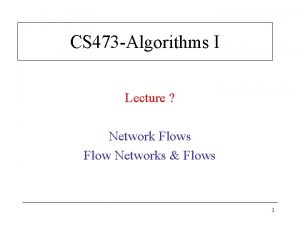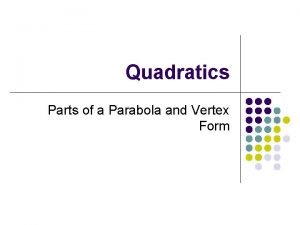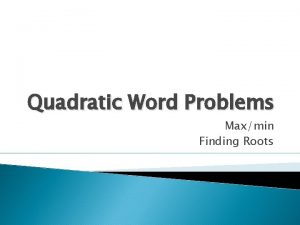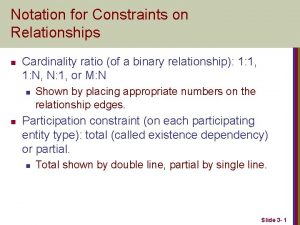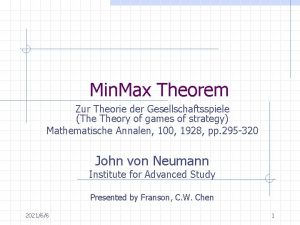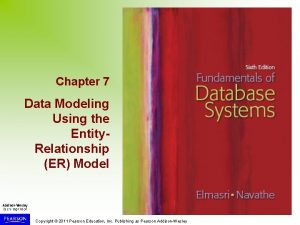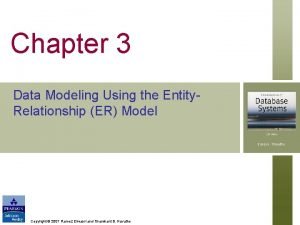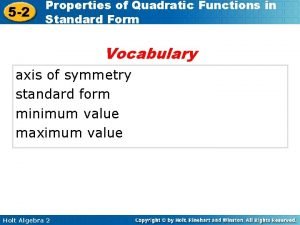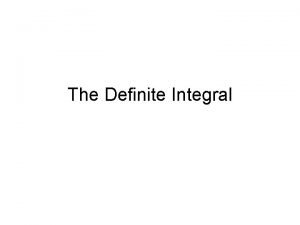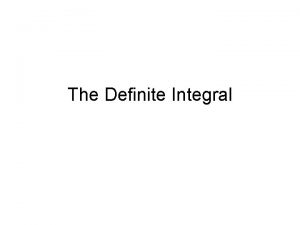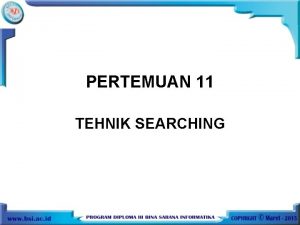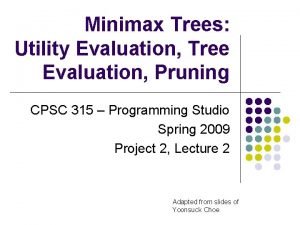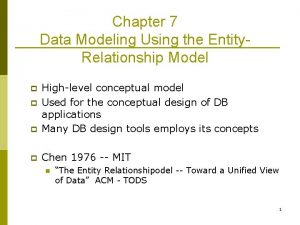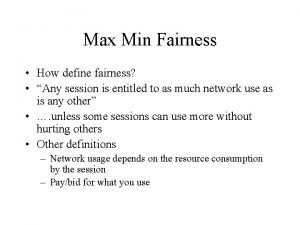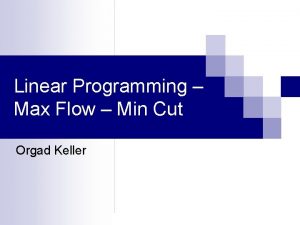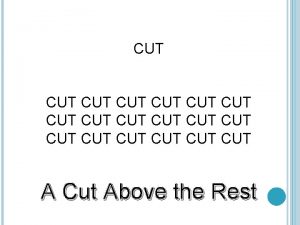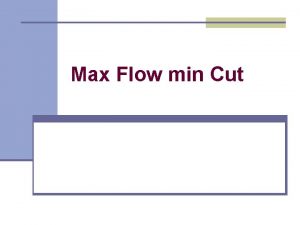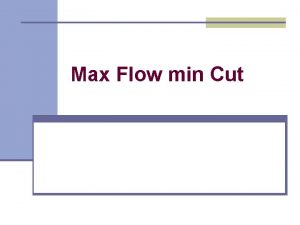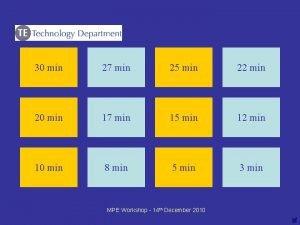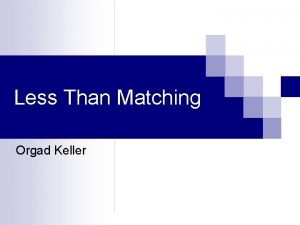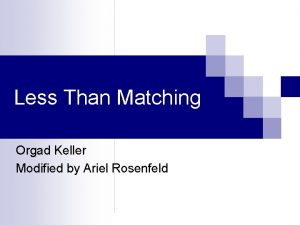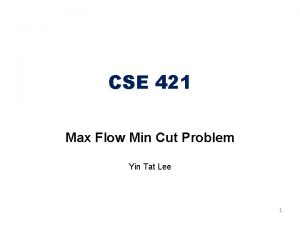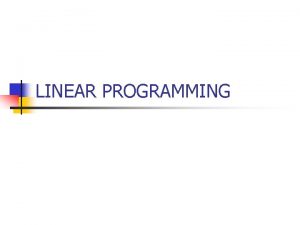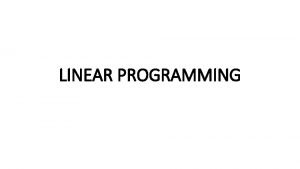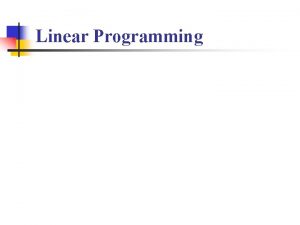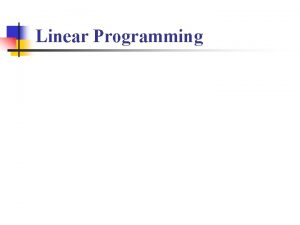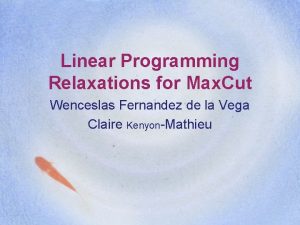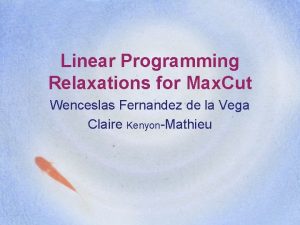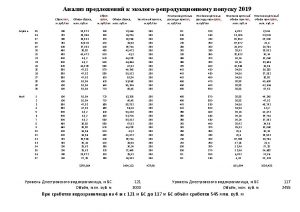Linear Programming Max Flow Min Cut Orgad Keller



























- Slides: 27

Linear Programming – Max Flow – Min Cut Orgad Keller

Linear Programming n We have an objective function: n Subject to constraints: Orgad Keller - Algorithms 2 2

Linear Programming n Given all parameters n we want to find the optimal Orgad Keller - Algorithms 2 - 3

Linear Programming n It is easier to present the problem with a matrix and vectors: Orgad Keller - Algorithms 2 - 4

The Dual Problem n Given the Primal Problem: n It’s Dual Problem is defined as: Orgad Keller - Algorithms 2 - 5

Strong Duality Theorem n Given a problem and it’s dual problem, then: n In other words, the optimal objective function’s value for the primal problem, is equal to the optimal objective function’s value for the dual problem. Orgad Keller - Algorithms 2 - 6

Maximum Flow As you remember from Algorithms I n Given a directed graph , two vertices and a capacity for each edge n We want to find a flow function so that the flow value is maximal n Orgad Keller - Algorithms 2 - 7

Maximum Flow n But, we are subject to some rules: ¨ ¨What ¨ goes in must come out: Capacity restrictions: Orgad Keller - Algorithms 2 - 8

Max Flow with Linear Programming n We’ll show by a simple example: 1 3 2 Orgad Keller - Algorithms 2 - 9

Max Flow with Linear Programming n We want to present the example in the form: ¨ Subject to: Orgad Keller - Algorithms 2 - 10

Max Flow with Linear Programming n Formally: 3 1 1 2 3 But we don’t permit equalities Orgad Keller - Algorithms 2 - 11

Max Flow with Linear Programming ¨ So we’ll add another edge, and change the problem’s representation a little. 3 1 1 3 2 ∞ Orgad Keller - Algorithms 2 - 12

Orgad Keller - Algorithms 2 - 13

Orgad Keller - Algorithms 2 - 14

Minimum Cut As you remember from Algorithms I n Given a directed graph , two vertices and a weight for each edge n We want to find a minimal-weight subset of edges such that if we’ll remove them, we won’t be able to travel from to. n Orgad Keller - Algorithms 2 - 15

Minimum Cut n In other words: ¨ We’ll choose , where: , , such that the cut value, is minimal. Orgad Keller - Algorithms 2 - 16

Min Cut with Linear Programming n Going back to the example: 1 3 2 Orgad Keller - Algorithms 2 - 17

Min Cut with Linear Programming 3 n 1 1 What about: 3 2 This look like And we know that ¨ Is that enough? ¨ We haven’t ensured paths from Orgad Keller - Algorithms 2 - to are cut. 18

Min Cut with Linear Programming 3 n Beside a variable for every edge , we’ll want a variable for every vertex such that: Orgad Keller - Algorithms 2 - 1 1 2 3 , 19

Min Cut with Linear Programming 3 n Let’s take ¨ If for instance: is in the cut , that ¨ If is not in the cut that either or ¨ So 1 1 2 3 that means , that means or it is the same to constrain: Orgad Keller - Algorithms 2 - 20

Max Flow with Linear Programming n Formally: 3 1 1 2 3 In order to ensure Orgad Keller - Algorithms 2 - 21

Orgad Keller - Algorithms 2 - 22

Orgad Keller - Algorithms 2 - 23

Orgad Keller - Algorithms 2 - 24

Max Flow – Min Cut Theorem We now see that the problems are dual n So also according to the Strong Duality Theorem, Max Flow = Min Cut n Orgad Keller - Algorithms 2 - 25

Integer Values We want integer values for the variables, but this is LP, not IP! n So how do we know that the solution will yield integer values for the variables? n Theroem: If the constraints matrix is totally unimodular and the right hand side is comprised of integers, then it’s easy to find an integer solution. n Orgad Keller - Algorithms 2 - 26

Unimodular / Totally Unimodular Definition: A Unimodular matrix is a square matrix whose determinant is 0, 1 or -1. n Definition: A Totally Unimodular matrix is a matrix whose every non-singular square submatrix is unimodular. n Orgad Keller - Algorithms 2 - 27
 Flow g cut
Flow g cut Max flow min cut problem
Max flow min cut problem Perbedaan linear programming dan integer programming
Perbedaan linear programming dan integer programming Linear vs integer programming
Linear vs integer programming Definisi integer
Definisi integer Min max normalization example
Min max normalization example Absolute max vs local max
Absolute max vs local max Vertex.form
Vertex.form Maximum minimum word problems
Maximum minimum word problems Relative vs absolute max and min
Relative vs absolute max and min Cardinality min max notation
Cardinality min max notation Min max theorem
Min max theorem Symmetric min-max heap
Symmetric min-max heap Ramez elmasri
Ramez elmasri Min max notation er diagram
Min max notation er diagram Properties of quadratic functions
Properties of quadratic functions Minimum and maximum of a quadratic function
Minimum and maximum of a quadratic function Is integral the area under a curve
Is integral the area under a curve How to read summation notation
How to read summation notation Contoh dari teknik pencarian searching tunggal adalah
Contoh dari teknik pencarian searching tunggal adalah Min max algorithm
Min max algorithm Maxterm notation
Maxterm notation Minimax algorithm
Minimax algorithm Symmetric min max heap
Symmetric min max heap Erm kardinalitäten min max
Erm kardinalitäten min max Min max notation er diagram
Min max notation er diagram Min max notation er diagram
Min max notation er diagram Max-min fairness example
Max-min fairness example
